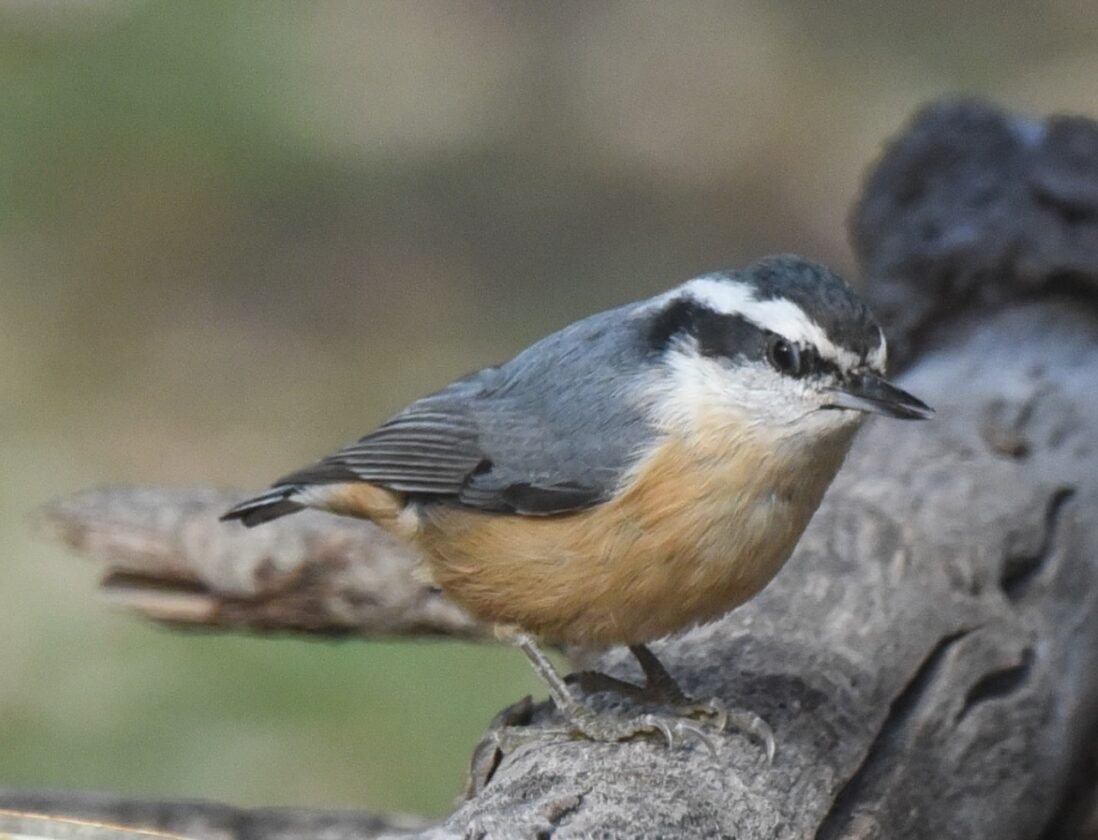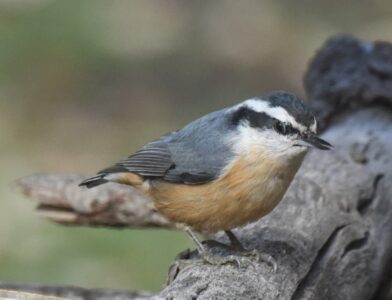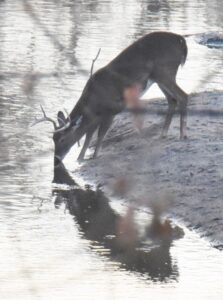Big or small, I like them all

PHOTOS BY GARRY BRANDENBURG — Wildlife comes in all sizes and shapes. One of the largest animals that we commonly observe is the white-tailed deer, and on the smaller scale of things, a Red-breasted Nuthatch is also worthy of our scrutiny. This past week, both species captured this author’s attention, enough so that making photographic images of them became a must do task. The white-tailed buck had stealthily slipped out of the cover of riverside willows to make his way across a sandbar to get a drink. As for the flighty and never sitting still very long little bird, the Red-breasted Nuthatch, capturing images of it was difficult. I enjoy them all, big or small.
Deer hunting season is in full swing for archers. I am just one of several thousand avid archers living in Iowa who enjoy time spent observing all kinds of natural happenings, listening to the sounds of nature from tall tree stand perches and seeing the usual and sometimes unique occurrences as wildlife species of all sizes and shapes go about their daily business of living.
Yes, there can be long stretches of time when not much is happening, and then when I am least expecting it, a new moment of excitement takes place. I have to be alert at all times, even though I must confess that it takes concentration to avoid becoming too complacent.
It is way too easy for an event to unfold where I was not looking and realize too late that I may have paid the price for not keeping my eyes and head and a slow swivel. Hunting can be all of the above. It is fun to be outside watching and waiting, applying my skills against the alert senses of wild critters.
So far this deer season, I have about 45 hours of tree stand or ground blind settings logged into my notebook. Deer get maximum attention even though many of them are too far away, or traveling on a pathway not likely to bring them closer to my location.
However, a few do pass by very close which allows for very good observation time. When that happens, I remain still, moving only my eyes and slowly turning my head. A good set of camo clothing assists in staying undetected.

Wind direction is critical, and for those that are not hunters, which is okay, having a deer close does not in any way mean I will be trying to bring an arrow to full draw on it. I am very selective by my choices of which deer to attempt to take.
A perfect example was a recent episode when a button buck, a male fawn born this year, walked directly under my tree while I watched from above. It was a non-shooting scenario for me. However, the adult doe deer behind me was always standing or moving through heavy brush in which she never presented a situation where I could draw my bow.
She didn’t know I was watching. Still, she was wise to use available cover to her advantage at all times. She ultimately just calmly walked away, never suspecting that a hunter was watching.
The list of wild critters I have observed in close quarters situations just this season is long. It includes many birds of all sizes from Bald Eagles to wrens. A flock of robins filtered through the trees recently as they were migrating southward.
Hen and rooster pheasants have flown at low levels over grassy fields. Wild turkeys play follow the leader before they fly into tall trees for their nightly roosts. Owls call and even sometimes fly very close as they inspect me, veering away at the last second when they realize I am not a prey item for their talons. I have seen all kinds of warblers, those very small and active insect hunters bouncing from branch to branch as they probe under tree bark to locate a morsel to eat.
Perhaps this weekend, while I apply another warm layer of heavy insulating coats and coveralls, I may get a chance to watch a few snowflakes filter out of the sky. Some of my past hunting episodes have found the ground dry and brown when I entered the forest.
However, when I left my stand a few hours later for a long walk out, my boots left tracks in the snow. Nature offered a complete transformation of her landscape. A hunter needs to be prepared for the game they seek and for the weather that Mom Nature will send, which reminds me of the saying “There is no bad weather, only bad clothes.”
————
Red-Breasted Nuthatch birds are tiny, quick, and spunky as they pursue their intense game of finding food sources. This fall and winter, they will be active trying to find any insect larvae, caterpillars or ants.
They will eat from feeders put out by people. They will take sunflower seeds, suet, or peanuts. A food item that is too large will be jammed into a tree crevice and then using its tiny but strong beak will hammer the food item until it is opened.
Observing their feeding behavior, Red-breasted nuthatches can go upside down, up or down, and use a long rearward directed toe on their foot to help hold their grip. Gravity seems to not be an obstacle for this bird.
A distinctive identification difference of Red-breasted nuthatches compared to White-breasted nuthatches is the dark eye line on the sides of their heads and a rusty reddish color to the feathers of its chest and underbody. Take the time to note those differences by consulting a good bird identification book. Best of all, enjoy this bird when and if you see it.
————
Deer hunting registrations of animals killed by hunters is tabulated and is called the Deer and Turkey Harvest Report. An online examination of the data as of midweek shows that statewide, about 18,900 deer have been removed from the population. By Jan. 10 of next year, that number will exceed 100,000.
Marshall County deer hunters so far have taken 96 animals. Grundy County has a tab of 28. Tama shows 223. Story is on board with 145, Poweshiek at 105, Jasper with 157 and Hardin at 172.
Statewide at this point, 54 percent of the deer are males and 46 percent are doe deer. Here are some interesting myths about deer. 1. Deer always move at dawn and dusk. Well, yes and no. Trail camera images prove they move at any time of the day or night. Being an animal with crepuscular habits, meaning a preference for dusk or dawn, this is not always true.
Especially now during the first two weeks of November, the rut or mating season is becoming a full time endeavor for doe and bucks. Lots of deer can be seen or hunted at all times of the day if one is willing to commit to an all day sit in a blind or tree stand.
2. Another myth is titled overhunting a stand. Somehow the myth was formed by the theory of leaving too much human scent at the location. The truth is that a stand can be used repeatedly if due diligence is used with showering in scent free soap, having scent free clothing and using ingress and egress methods that are quiet.
3. If another person walks by your public land tree stand or blind, the day is toast. Not so. Sit still and remain where you are. With deer, anything can happen so just stay alert.
4. Another myth is to stay out of the best spots until all wind and weather conditions are favorable. This is not a bad idea, but sometimes you just have to go where you want to go. Just do it.
5. Big areas versus small plots. The myth seems to offer a big timber/bigger deer option. Every year a small plot somewhere yields big antlered deer.
6. If you miss a buck, it is game over. Well, again this is a yes and no situation. This author hit a big buck in 2005 after the first arrow missed. When the buck returned, the second arrow did not miss. That buck scored 161 5/8 and is now in the Pope and Young Club archery record book. Lastly, hunting during full moon times of the month has its detractors. Fact: Deer can see as well at night as we can during the day time, moon or no moon, cloudy skies or clear. Just go deer hunting when your schedule allows.
————
Christmas trees will go on sale at the Izaak Walton League land beginning Nov. 25, 26 and 27 from 10 a.m. until 4 p.m. Each weekend after that on Dec. 3-4, 10-11 and 17-18 from 10 a.m. until 4 p.m. are the other dates.
These are cut your own tree and pay $50 per tree, any size. Do bring a truck or trailer to put the tree into and tie it down securely before any road travel. Ikes members will have hand saws to borrow, and the Ikes have a tree shaker to try and dislodge old needles. Enjoy the Christmas season with a fresh grown and fresh cut conifer tree.
————
Garry Brandenburg is the retired director of the Marshall County Conservation Board. He is a graduate of Iowa State University with a BS degree in Fish & Wildlife Biology.
Contact him at:
P.O. Box 96
Albion, IA 50005
- PHOTOS BY GARRY BRANDENBURG — Wildlife comes in all sizes and shapes. One of the largest animals that we commonly observe is the white-tailed deer, and on the smaller scale of things, a Red-breasted Nuthatch is also worthy of our scrutiny. This past week, both species captured this author’s attention, enough so that making photographic images of them became a must do task. The white-tailed buck had stealthily slipped out of the cover of riverside willows to make his way across a sandbar to get a drink. As for the flighty and never sitting still very long little bird, the Red-breasted Nuthatch, capturing images of it was difficult. I enjoy them all, big or small.








